Huawei Nova 3i vs OPPO F9 Specs, Benchmark Scores, Price, and Design : A Comparative Review
When Huawei Nova 3i was officially launched globally on the last week of July 2018, many tech bloggers and editors called it the "New Midrange King" largely because of its stellar design, build, set of technical specifications, and imaging capabilities.
Fast forward to September 2018, does Huawei's popular mid-level release still get to keep the crown on its head in the face of serious competition posed by its rival manufacturers from China?

As of writing, Huawei Nova 3i's main rival in the Philippine market appears to be the all-new OPPO F9, which was formally introduced to local bloggers, dealers, and members of the media on August 15, 2018.

These two top-notch handsets were immediately pitted against each other largely because of their rather similar design and build as well as their comparable imaging features and internal hardware.
But which of the two is actually better and worth your hard-earned money?
In this TechPinas Comparison Post, I will try to answer that question - for the benefit of Pinoy mobile consumers - by doing a side-by-side comparison of their design, set of specs, price, and even benchmark scores -- in the most fair way that I can.

To make the comparison easier, I've included actual photos of these much-talked-about smartphone models along with the meticulous technical specifications table below, which makes it more convenient to spot the exact similarities or differences between these renowned midrange devices.
Alright! Let me jump straight to my commentary.
Design, Build, and Display
As you can see in these photos, Huawei Nova 3i and OPPO F9 share largely identical design language with some variance here and there.
The two phones have a rectangle with rounded corners form factor as well as a luxurious glass sandwich look although it is believed that OPPO F9 features polished acrylic back panel in lieu of real glass. Aside from that, these handsets share the exact same 169 grams heft and overall feel in the hand.
So how are they different in terms of looks?
Obviously, they come in different color variants, Huawei Nova 3i is available in Iris Purple (my favorite), Black, and Pearl White. On the other hand, OPPO F9 is currently out in Sunrise Red and Twilight Blue with Petal Pattern at the back, and - eventually - Starry Purple.
The Iris Purple gradient finish of the Huawei Nova 3i has proven to be a real hit among Pinoys. In fact, this tone has been adopted by stylists and fashionistas not only in their outfits but also in the color of their hair. I guess that says something about Huawei's inclination to cater to the hip and trendy crowd who love expressing themselves through the colors and the designs of their outfits and gadgets.
Aside from the phones' colors, their camera modules at the back have different orientations. The one on Nova 3i is positioned vertically while OPPO F9 has it horizontally. Also, the Fingerprint Scanner below the cameras have a different shape on each phone; It's a perfect circle on the Nova 3i and oblong on the OPPO F9.
Even the position of the hardware buttons vary on each device. The power button is placed on the right panel on both phones but the one on the Nova 3i is slightly closer to the middle. The volume up and down buttons of the OPPO F9 are both placed on the left panel while Huawei Nova 3i has them also on the right panel, just above the power button.

Which model has the better button placement? It depends on the user. If you just like using your thumb to do the clicking, Nova 3i would be better for you. But if you like using multiple fingers to do the task, you might lean towards OPPO F9.
Now, as for their displays, these two actually share the same 6.3-inch FullHD+ IPS screen. However, Nova 3i's is taller as it has a 19.5:9 Aspect Ratio compared to 19:9 for the OPPO F9.
As shown in the image below, the display of each phone features a notch. The one on the OPPO F9 has a smaller waterdrop look while Nova 3i's is larger and looks more like that of the flagship-level Apple iPhone X.
What's good about Huawei Nova 3i's notch, however, is that it can easily be turned off by going to Settings > Display > Notch > Hide Notch.
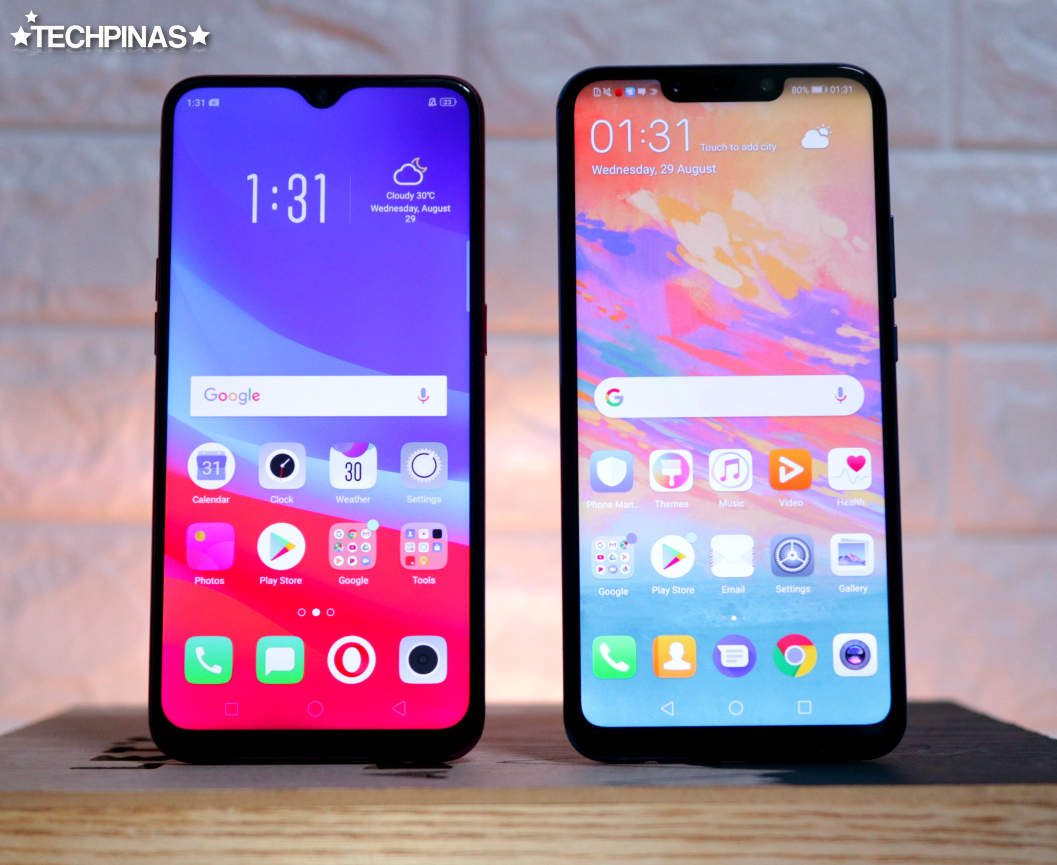
Imaging Capabilities
OPPO F9 and Huawei Nova 3i are powered by AI Imaging Technology that automatically figures out the subject in front of the camera - including food, people, greenery, and the sky, among others - and instantly tweaks the settings - like saturation, shadows, and highlights - to deliver the best shot possible.
For those who love taking selfies, the Nova 3i has two AI-powered cameras in front - a 24MP main snapper plus a 2MP Depth Sensor - while OPPO F9 only has one, which is a 25 MegaPixel f/2.0 cam powered by the company's AI Beauty 2.1 software that's made to capture the real you.
In my experience using both handsets, Nova 3i tends to deliver brighter selfies with more aggressive skin clearing while OPPO F9 tends to have smarter beautification effects to show your real facial features.
Since Huawei Nova 3i has a two front camera module, I find that it also gives you a slightly more refined bokeh effect for self-portraits wherein the background of the subject is beautifully blurred. I guess that secondary cam really helps. Also, the depth sensor helps power the handset's AR Lens for , which includes fun effects like 3D Qmoji and Backgrounds for Selfie Videos, which are so fun to use!
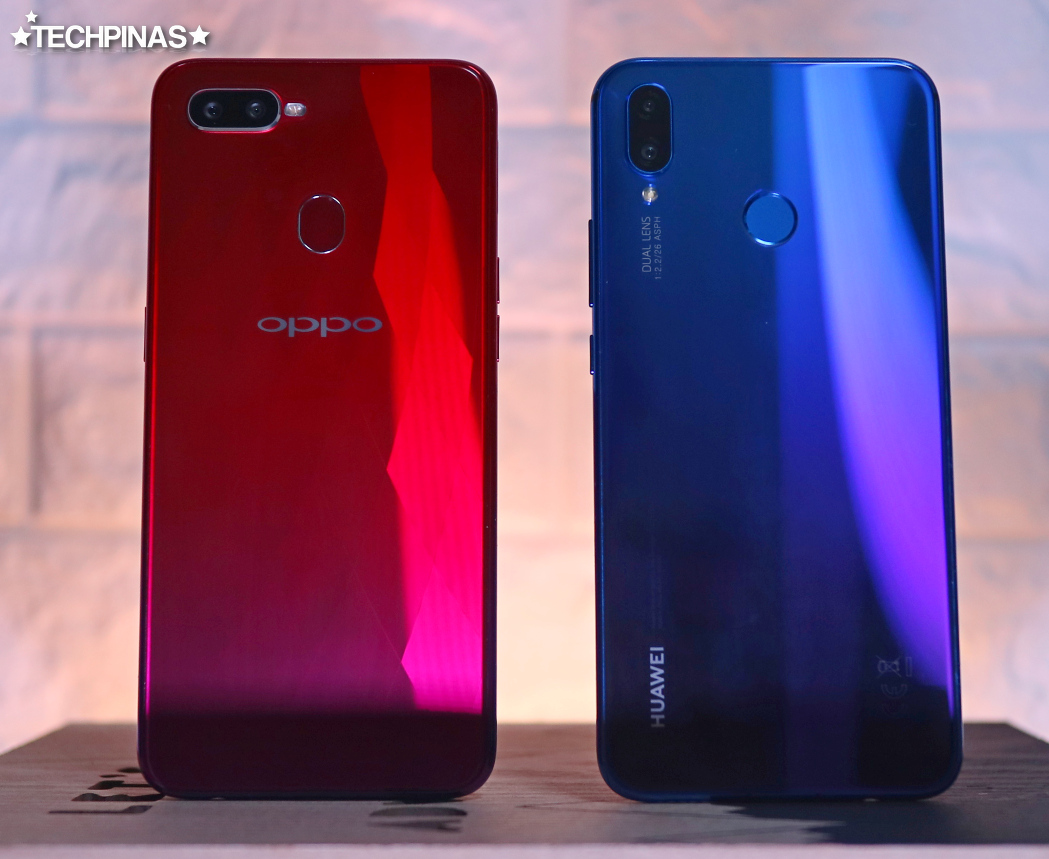
As for the rear camera, both phones feature an AI-Powered 16MP primary cam + 2MP depth sensor that work together to give shallow depth of field effect on portrait, food, or product shots.
Both cameraphones are very reliable in capturing images and videos of various subjects with the Nova 3i often giving brighter shots with warmer tone in well-lit settings. However, frankly, in low light conditions OPPO F9 has an edge because of its primary cam's wider f/2.0 aperture and electronic image stabilization.
Reference: Sample Photos and Videos Taken Using Huawei Nova 3i and OPPO F9 (Youtube Video)
Internal Hardware and Benchmark Test Scores
As I've said, Huawei Nova 3i and OPPO F9 are very close when it comes to actual performance -- and that is proven by their 136,820 and 136,628 Antutu Benchmark Scores, respectively. It's really tight with Nova 3i scoring just a wee bit higher.
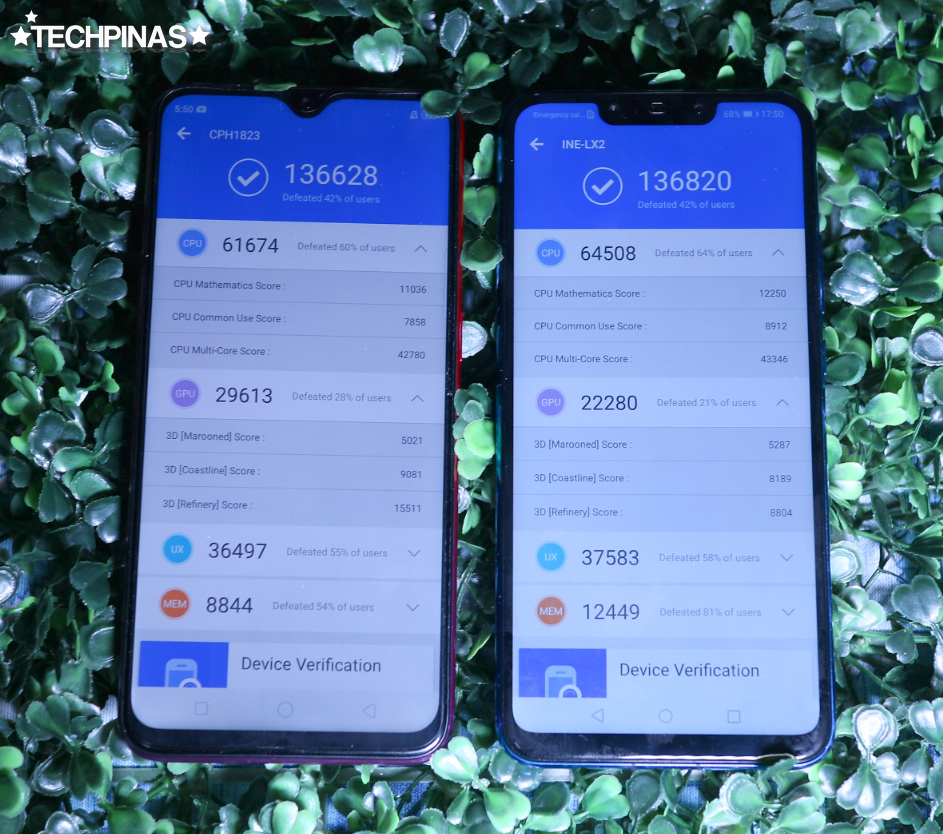
Looking at the scores, it's clear that the newer Kirin 710 processor of Nova 3i has more powerful multi-core computing performance -- but the Mali-G72 MP3 GPU of the older MediaTek Helio P60 chipset of the OPPO F9 is its saving grace, outperforming the Mali-G51 MP4 GPU of the Kirin 710.
I would give better multitasking performance to OPPO F9 because of its larger 6GB of RAM over just 4GB for the Nova 3i -- but when it comes to internal storage space, the Huawei Nova 3i is the clear winner with a whopping 128GB of ROM versus just 64GB for the competing phone.
Both handsets have a microSD card slot but the one in OPPO F9 is dedicated while Nova 3i has a secondary hybrid nanoSIM slot that can also take in a microSD card. Given the sheer size of Nova 3i's storage, though, I think it will take a long while before you will find the need to transfer files or to even consider getting a microSD card for additional space.
Battery Life and Fast Charging Features
Considering that F9's battery has a higher 3,400 mAh capacity compared to 3,340 mAh on the Nova 3i, I was expecting OPPO's hero midrange model to easily win this round.
That's why I was shocked when Nova 3i outlasted the F9 by more than an hour when I ran the PCMark Battery Life test on both phones. I mean look at the results. (I guess I'll have to run it again to confirm this. I remain baffled, actually. But hey, kudos to Huawei!)
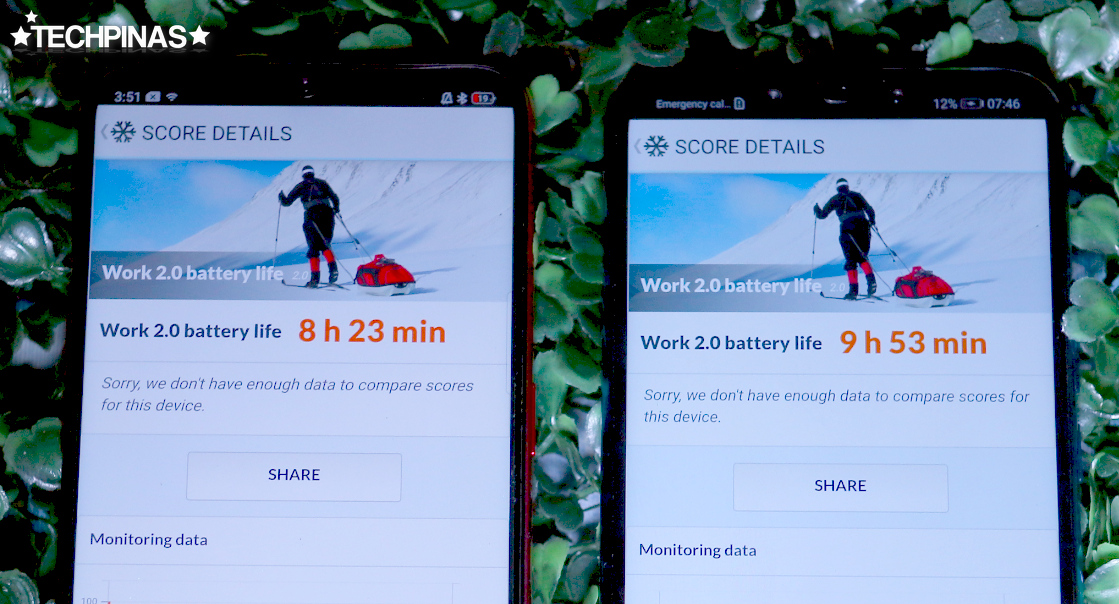
Good thing OPPO F9 has the company's patented Flash Charge technology that can give the handset up to 2 hours of talk time with just 5 minutes of charging using the provided travel charger and microUSB to USB connector cable.
Based on the results shown above, however, it's clear that when it comes to battery life on a full charge, Huawei Nova 3i wins.

Connectivity and Security Features
Looking at the table, it's clear that the two phones are pretty even in this department. They both support Dual SIM Dual Standby, USB OTG, WiFi 802.11 a/b/g/n, Bluetooth 4.2, and 4G LTE Cat 13 mobile connectivity.
For user protection, OPPO F9 and Huawei Nova 3i both have a Fingerprint Scanner at the back and a Facial Recognition software integrated into the front cam, providing a veritable later of privacy and security for their owners.
Operating System and User Interface
These two smartphones both run the Android 8.1 Oreo Operating System and benefit from all improvements that Google had implemented on this fairly updated version of its mobile OS.
Even their individual UIs, Color OS 5.2 for the F9 and EMUI 8.2 for the Nova 3i, look just as neat and organized. They are also uncomplicated to use as they don't have an app drawer which many users - apparently - aren't all that comfortable with.
Despite the similarities, though, both UIs have several unique offerings. For instance, Color OS 5.2 gives functionality to the notch by allowing users to swipe on other sides while watching videos or playing games to access messages, to take screenshots, or to record the display without leaving the application. On the other hand, EMUI has useful value-added features like PrivateSpace that lets you create a separate zone in your device that only you can access and Voice Control which allows you to quickly initiate calls when the screen is turned off just by talking to your phone, among others.
Price
Well, this one is pretty easy. Huawei Nova 3i is more affordable by PHP 2,000. It dons an official suggested retail price of PHP 15,990 while OPPO F9 sells for PHP 17,990.
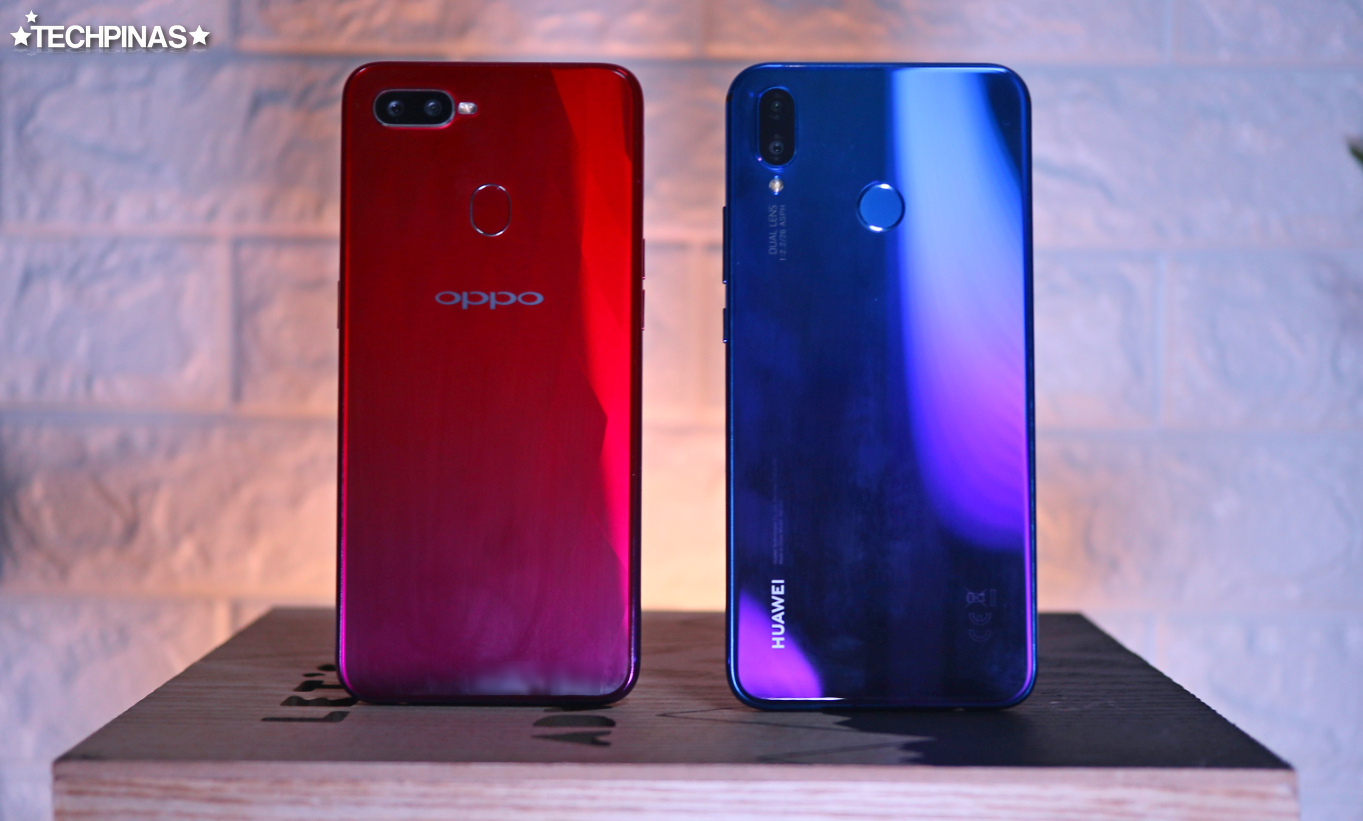
So Which 2018 Hero Midrange Smartphone is Better?
The truth is, you can't go wrong choosing either of these smartphones. Having tested both models, I would say that each of them has their own strengths and weaknesses that balance each other out to make these handsets true shoulder-to-shoulder competitors.
My opinion, though, is that if you can let go of some of the unique selling points that OPPO F9 offers - including EIS and the wider aperture of the primary rear camera - to save PHP 2,000, just go for the Huawei Nova 3i. But if you must have those features, then - by all means - go ahead and spend more.
If you choose the Huawei Nova 3i, though, I'm sure you will appreciate the four-camera set-up, the larger storage space for all your photos, videos and other important files, the handset's luxurious real glass back panel, and of course, the fun AR effects for Selfie Videos.
Fast forward to September 2018, does Huawei's popular mid-level release still get to keep the crown on its head in the face of serious competition posed by its rival manufacturers from China?

As of writing, Huawei Nova 3i's main rival in the Philippine market appears to be the all-new OPPO F9, which was formally introduced to local bloggers, dealers, and members of the media on August 15, 2018.

These two top-notch handsets were immediately pitted against each other largely because of their rather similar design and build as well as their comparable imaging features and internal hardware.
But which of the two is actually better and worth your hard-earned money?
In this TechPinas Comparison Post, I will try to answer that question - for the benefit of Pinoy mobile consumers - by doing a side-by-side comparison of their design, set of specs, price, and even benchmark scores -- in the most fair way that I can.

To make the comparison easier, I've included actual photos of these much-talked-about smartphone models along with the meticulous technical specifications table below, which makes it more convenient to spot the exact similarities or differences between these renowned midrange devices.
TechPinas Smartphone Technical Specifications Table
| ||
OPPO F9
|
Huawei Nova 3i
| |
| Dimensions | 156.7 x 74 x 8 mm | 157.6 x 75.2 x 7.6 mm |
| Weight | 169 grams | 169 grams |
| Display | 6.23 inches, FullHD+ 1080 x 2280 pixels, 19:9 Aspect Ratio, LTPS LCD, 405 ppi | 6.3 inches FullHD+ 1080 x 2340 pixels, 19.5:9 Aspect Ratio, 409 ppi, IPS Display |
| Screen to Body Ratio | 84% Screen to Body Ratio | 82.2% Screen To Body Ratio |
| Notch | Yes, Waterdrop | Yes, Oblong |
| Screen Protection | Corning Gorilla Glass 6 | Scratch Resistant Glass (TBS) |
| Front Selfie Camera | 25 MegaPixels, f/2.0, AI Beauty 2.1 | Dual Front Facing Camera 24 MegaPixels + 2 MegaPixels Depth Sensor |
| Rear Camera | Dual Rear Camera: 16 MegaPixels, f/1.8, PDAF + 2MP Depth Sensor, AI Imaging Technology, LED Flash | Dual Rear Camera: 16 MegaPixels f/2.2 PDAF + 2 MP f/2.4 Depth Sensor, AI Imaging Technology, LED Flash |
| Video Recorder | Rear Video Recorder: FullHD 1080p 30fps with EIS Front Video Recorder: 1080p 30fps | Rear Video Recorder: FullHD 1080p 30fps Front Video Recorder: 1080p 30fps |
| User Interface | Color OS 5.2 | EMUI 8.2 User Interface |
| Operating System | Android 8.1 Oreo | Android 8.1 Oreo |
| Chipset | 12nm Octa-Core (4 x 2.0 GHz ARM Cortex-A73 + 4 x 2.0 GHz ARM Cortex-A53), MediaTek Helio P60 Processor | 12nm Octa Core (4 x 2.2 GHz ARM Cortex-A73 + 4 x 1.7 GHz ARM Cortex-A53) Hisilicon Kirin 710 |
| GPU | Mali-G72 MP3 | Mali-G51 MP4 |
| RAM | 6GB | 4GB |
| ROM | 64GB | 128GB |
| microSD Card Slot | Yes, Dedicated | Yes, via Secondary Hybrid nanoSIM Card Slot |
| Battery | Non-Removable Li-Po 3,400 mAh | Non-Removable Li-Po 3,340 mAh |
| Charging Port | microUSB 2.0, VOOC Flash Charge | microUSB 2.0 |
| WiFi | 802.11 a/b/g/n | 802.11 a/b/g/n/ac |
| Bluetooth | 4.2 | 4.2 |
| 4G LTE | Yes, Cat13 | Yes, Cat13 |
| Dual SIM Capability | Yes, Two nanoSIM Slots | Yes, Two nanoSIM Slots |
| Gyroscope | Yes | Yes |
| USB On-The-Go | Yes | Yes |
| Fingerprint Scanner | Yes | Yes |
| Facial Recognition | Yes | Yes |
| Protection Against The Elements | No | No |
| Colors | Sunrise Red, Twilight Blue, Starry Purple - with Petal-Shaped Pattern Design | Black, Pearl White, Iris Purple Premium Gradient |
| Availability | 1st week of September 2018 | July 28, 2018 |
| Official Suggested Retail Price in the Philippines | PHP 17,990 | PHP 15,990 |
Alright! Let me jump straight to my commentary.
Design, Build, and Display
As you can see in these photos, Huawei Nova 3i and OPPO F9 share largely identical design language with some variance here and there.
The two phones have a rectangle with rounded corners form factor as well as a luxurious glass sandwich look although it is believed that OPPO F9 features polished acrylic back panel in lieu of real glass. Aside from that, these handsets share the exact same 169 grams heft and overall feel in the hand.
So how are they different in terms of looks?
Obviously, they come in different color variants, Huawei Nova 3i is available in Iris Purple (my favorite), Black, and Pearl White. On the other hand, OPPO F9 is currently out in Sunrise Red and Twilight Blue with Petal Pattern at the back, and - eventually - Starry Purple.
The Iris Purple gradient finish of the Huawei Nova 3i has proven to be a real hit among Pinoys. In fact, this tone has been adopted by stylists and fashionistas not only in their outfits but also in the color of their hair. I guess that says something about Huawei's inclination to cater to the hip and trendy crowd who love expressing themselves through the colors and the designs of their outfits and gadgets.
Aside from the phones' colors, their camera modules at the back have different orientations. The one on Nova 3i is positioned vertically while OPPO F9 has it horizontally. Also, the Fingerprint Scanner below the cameras have a different shape on each phone; It's a perfect circle on the Nova 3i and oblong on the OPPO F9.
Even the position of the hardware buttons vary on each device. The power button is placed on the right panel on both phones but the one on the Nova 3i is slightly closer to the middle. The volume up and down buttons of the OPPO F9 are both placed on the left panel while Huawei Nova 3i has them also on the right panel, just above the power button.

Which model has the better button placement? It depends on the user. If you just like using your thumb to do the clicking, Nova 3i would be better for you. But if you like using multiple fingers to do the task, you might lean towards OPPO F9.
Now, as for their displays, these two actually share the same 6.3-inch FullHD+ IPS screen. However, Nova 3i's is taller as it has a 19.5:9 Aspect Ratio compared to 19:9 for the OPPO F9.
As shown in the image below, the display of each phone features a notch. The one on the OPPO F9 has a smaller waterdrop look while Nova 3i's is larger and looks more like that of the flagship-level Apple iPhone X.
What's good about Huawei Nova 3i's notch, however, is that it can easily be turned off by going to Settings > Display > Notch > Hide Notch.

Imaging Capabilities
OPPO F9 and Huawei Nova 3i are powered by AI Imaging Technology that automatically figures out the subject in front of the camera - including food, people, greenery, and the sky, among others - and instantly tweaks the settings - like saturation, shadows, and highlights - to deliver the best shot possible.
For those who love taking selfies, the Nova 3i has two AI-powered cameras in front - a 24MP main snapper plus a 2MP Depth Sensor - while OPPO F9 only has one, which is a 25 MegaPixel f/2.0 cam powered by the company's AI Beauty 2.1 software that's made to capture the real you.
In my experience using both handsets, Nova 3i tends to deliver brighter selfies with more aggressive skin clearing while OPPO F9 tends to have smarter beautification effects to show your real facial features.
Since Huawei Nova 3i has a two front camera module, I find that it also gives you a slightly more refined bokeh effect for self-portraits wherein the background of the subject is beautifully blurred. I guess that secondary cam really helps. Also, the depth sensor helps power the handset's AR Lens for , which includes fun effects like 3D Qmoji and Backgrounds for Selfie Videos, which are so fun to use!

As for the rear camera, both phones feature an AI-Powered 16MP primary cam + 2MP depth sensor that work together to give shallow depth of field effect on portrait, food, or product shots.
Both cameraphones are very reliable in capturing images and videos of various subjects with the Nova 3i often giving brighter shots with warmer tone in well-lit settings. However, frankly, in low light conditions OPPO F9 has an edge because of its primary cam's wider f/2.0 aperture and electronic image stabilization.
Reference: Sample Photos and Videos Taken Using Huawei Nova 3i and OPPO F9 (Youtube Video)
Internal Hardware and Benchmark Test Scores
As I've said, Huawei Nova 3i and OPPO F9 are very close when it comes to actual performance -- and that is proven by their 136,820 and 136,628 Antutu Benchmark Scores, respectively. It's really tight with Nova 3i scoring just a wee bit higher.

Looking at the scores, it's clear that the newer Kirin 710 processor of Nova 3i has more powerful multi-core computing performance -- but the Mali-G72 MP3 GPU of the older MediaTek Helio P60 chipset of the OPPO F9 is its saving grace, outperforming the Mali-G51 MP4 GPU of the Kirin 710.
I would give better multitasking performance to OPPO F9 because of its larger 6GB of RAM over just 4GB for the Nova 3i -- but when it comes to internal storage space, the Huawei Nova 3i is the clear winner with a whopping 128GB of ROM versus just 64GB for the competing phone.
Both handsets have a microSD card slot but the one in OPPO F9 is dedicated while Nova 3i has a secondary hybrid nanoSIM slot that can also take in a microSD card. Given the sheer size of Nova 3i's storage, though, I think it will take a long while before you will find the need to transfer files or to even consider getting a microSD card for additional space.
Battery Life and Fast Charging Features
Considering that F9's battery has a higher 3,400 mAh capacity compared to 3,340 mAh on the Nova 3i, I was expecting OPPO's hero midrange model to easily win this round.
That's why I was shocked when Nova 3i outlasted the F9 by more than an hour when I ran the PCMark Battery Life test on both phones. I mean look at the results. (I guess I'll have to run it again to confirm this. I remain baffled, actually. But hey, kudos to Huawei!)

OPPO F9 and Huawei Nova 3i PCMark Battery Life Test Results, respetively.
Good thing OPPO F9 has the company's patented Flash Charge technology that can give the handset up to 2 hours of talk time with just 5 minutes of charging using the provided travel charger and microUSB to USB connector cable.
Based on the results shown above, however, it's clear that when it comes to battery life on a full charge, Huawei Nova 3i wins.

Connectivity and Security Features
Looking at the table, it's clear that the two phones are pretty even in this department. They both support Dual SIM Dual Standby, USB OTG, WiFi 802.11 a/b/g/n, Bluetooth 4.2, and 4G LTE Cat 13 mobile connectivity.
For user protection, OPPO F9 and Huawei Nova 3i both have a Fingerprint Scanner at the back and a Facial Recognition software integrated into the front cam, providing a veritable later of privacy and security for their owners.
Operating System and User Interface
These two smartphones both run the Android 8.1 Oreo Operating System and benefit from all improvements that Google had implemented on this fairly updated version of its mobile OS.
Even their individual UIs, Color OS 5.2 for the F9 and EMUI 8.2 for the Nova 3i, look just as neat and organized. They are also uncomplicated to use as they don't have an app drawer which many users - apparently - aren't all that comfortable with.
Despite the similarities, though, both UIs have several unique offerings. For instance, Color OS 5.2 gives functionality to the notch by allowing users to swipe on other sides while watching videos or playing games to access messages, to take screenshots, or to record the display without leaving the application. On the other hand, EMUI has useful value-added features like PrivateSpace that lets you create a separate zone in your device that only you can access and Voice Control which allows you to quickly initiate calls when the screen is turned off just by talking to your phone, among others.
Price
Well, this one is pretty easy. Huawei Nova 3i is more affordable by PHP 2,000. It dons an official suggested retail price of PHP 15,990 while OPPO F9 sells for PHP 17,990.

So Which 2018 Hero Midrange Smartphone is Better?
The truth is, you can't go wrong choosing either of these smartphones. Having tested both models, I would say that each of them has their own strengths and weaknesses that balance each other out to make these handsets true shoulder-to-shoulder competitors.
My opinion, though, is that if you can let go of some of the unique selling points that OPPO F9 offers - including EIS and the wider aperture of the primary rear camera - to save PHP 2,000, just go for the Huawei Nova 3i. But if you must have those features, then - by all means - go ahead and spend more.
If you choose the Huawei Nova 3i, though, I'm sure you will appreciate the four-camera set-up, the larger storage space for all your photos, videos and other important files, the handset's luxurious real glass back panel, and of course, the fun AR effects for Selfie Videos.
Labels:
Huawei
Huawei Nova 3i
Huawei Nova 3i vs OPPO F9
Oppo
OPPO F9
Smartphones
TechPinas Reviews
Versus

